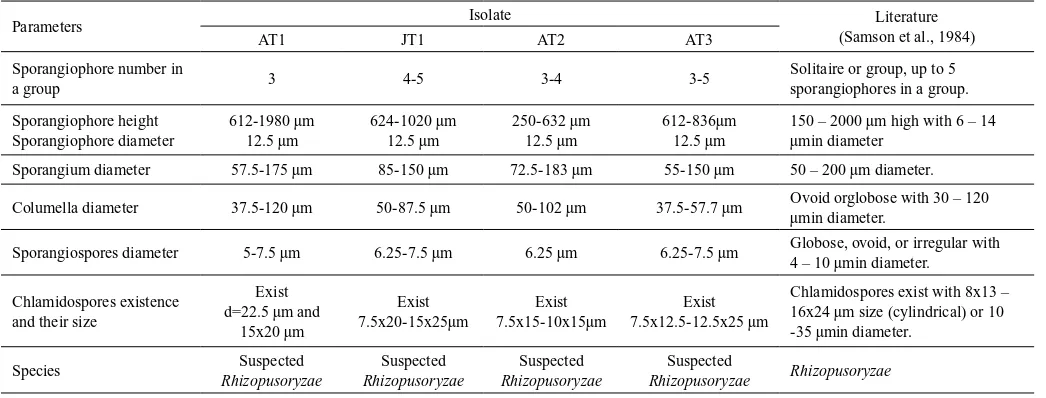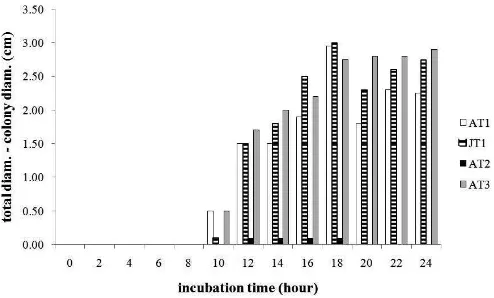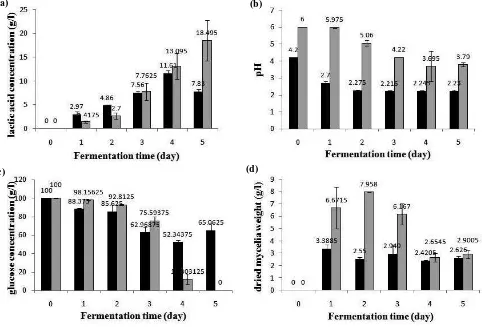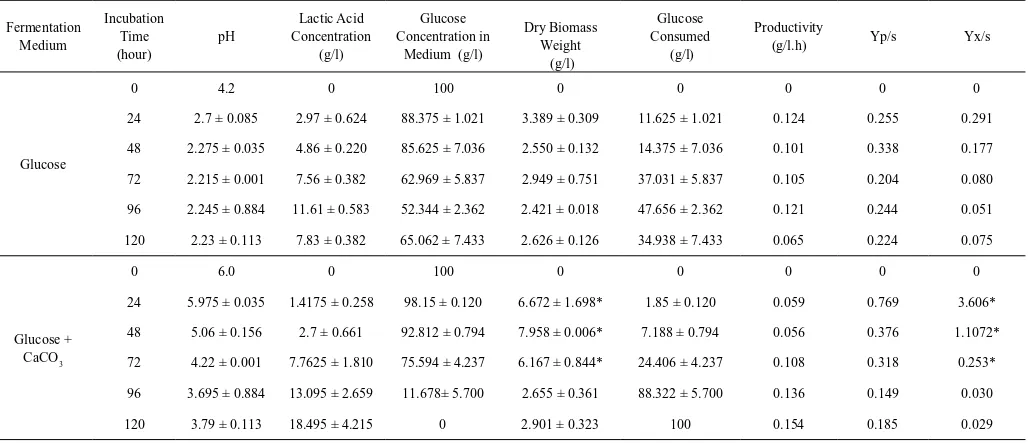ISOLATION OF
Rhizopus oryzae
FROM ROTTEN FRUIT AND ITS POTENCY
FOR LACTIC ACID PRODUCTION IN GLUCOSE MEDIUM WITH AND WITHOUT
ADDITION OF CALCIUM CARBONATE
Titik Kurniawati, Retno Indrati, Sardjono
Department of Food and Agricultural Product Technology, Faculty of Agricultural Technology, UniversitasGadjahMada,
Jl. Flora No.1 Bulaksumur, Yogyakarta, Indonesia 55281 Email: [email protected]
ABSTRACT
Studies on lactic acid production by filamentous fungi Rhizopus oryzae have been explored in the world. Unfortunately, these studies are still limited in Indonesia, particularly studies in lactic acid production by indigenous strain R. oryzae. Four strains obtained from rotten avocado and guava were potential in producing lactic acid (AT1, JT1, AT2, and AT3).
Rhizopusoryzae AT3 was used for lactic acid production using 100 g/l glucose medium with and without addition of 7.5 g/l calcium carbonate (CaCO3) at initial fermentation. Addition of CaCO3 increased lactic acid concentration of 59.30%, the concentrations were 11.61 g/l and 18.495 g/l in glucose medium and glucose medium with CaCO3 addition, respectively. Glucose+CaCO3 medium also showed higher productivity, reached continuously from 1 day (0.059 g/l/h) until 5 days fermentation (0.154 g/l/h), whereas highest productivity in glucose medium was reached at 1 day fermentation (0.124 g/l/h) and continued to decrease until 5 days fermentation (0.065 g/l/h).
Keywords: Lactic acid,Rhizopus oryzae, calcium carbonate, productivity
INTRODUCTION
Lactic acid (C3H6O3) is a valuable organic acid because of its wide use in food and food-related product. Lactic acid studies nowadays become popular with go green campaign, due to its ability to form poly lactic acid (PLA) which can be used as a material for manufacturing biodegradable polymer, including biodegradable plastic to solve one of global warming causes.
Basically lactic acid exists in 2 isomers, D(-)-lactic acid and L(+)-lactic acid. However, Abeysekaraet al. (2007) reported that D(-)-lactic acid potentially caused neurotoxicity in calf model. WHO also mentioned that elevated levels of D-lactic acid are harmful for humans (Zhanget al., 2007). L-isomer is more desired in lactic acid production. L(+)-lactic acid is preferred for food-related product and pharmaceutical industries due to its safety and its highcrystallinity which is suitable for commercial use (Wee et al, 2006).
Lactic acid can be synthesized by chemical and biological ways. Chemical synthesis occurs through lactonitrile pathway which forms racemic acid (D- and L-isomer) (Narayanan et al., 2004; Buyukkileci, 2007). Biological synthesis occurs through fermentation using microorganism such as lactic acid bacteria
(LAB) and R. oryzae. Lactic acid bacteria are well known as lactic acid producers due to its high productivity in producing lactic acid. However, LAB can produce both D- and L-isomer of lactic acid. On contrary, R. oryzae producesL(+)-lactic acid as the sole lactic acid in its metabolism. Besides, LAB are fastidious and requires complex nutrient for fermentation because of its limited ability to synthesize B-vitamins and amino acid (Yan et al., 2001). R. oryzae can grow better under limited nitrogen condition, if compared to LAB (Soccolet al., 2004). In addition, fermentation using R. oryzae will yield valuable by-product, fungal biomass, which can be used in biosorption processes for purification of contaminated effluent and as additive in animal feeds to improve the feed quality (Zhanget al., 2007). Comparing in downstream process, fermentation using R. oryzae has cheaper cost because of its easy separation between fungal biomass and fermentation broth. Ufortunately, studies on lactic acid production by
R. oryzaein Indonesia are still limited, so exploration of its potency is needed.
newly isolated R. oryzae indigenous strain required further investigation on its lactic acid production potency.
Lactic acid production can extremely decrease the pH of fermentation medium, out of the optimum pH range for R. oryzae growth (pH = 3.4-6). Neutralizing agents are usually used to solve this problem. Some studies used calcium carbonate (CaCO3) as neutralizing agent (Buyukkileci, 2007; Xiao et al., 2011; Gangulyet al., 2007). Effect of CaCO3 addition in fermentation process was also investigated in this study.
MATERIAL AND METHODS
The chemicals and media components employed in this study were purchased from Oxoid (Basingstoke, England), Sigma-Aldrich (St. Louis, MO, USA), and Merck (Darmstadt, Germany).
Isolation and Identification of R. oryzae
Isolation and identification of R. oryzae was carried out using direct plating method in Dichloran Rose Bengal Chloramphenicol (DRBC) and Malt Extract Agar (MEA) medium, respectively. Avocado and guava were used as samples to obtain the indigenous R. oryzae. In isolation step, the incubation was in 30oC for 4-6 days, while in identification
step it was 37oC for 7 days. Identification at species level was
refered to Samson et al. (1984).
Screening of Acid-Producing Fungi
Bromocresol Purple (BCP) agar medium was used for screening the R. oryzae isolates, in 30oC for 24 hours.
BCP agar contains BCP indicator which shows yellow color in pH=<5.2 and purple color in neutral pH (pH=6.8). Acid production was observed every 2 hours, by calculating the
total diameter formed (colony and yellow zone around) minus diameter of colony (purple zone). The most potential isolate was used for lactic acid production.
Lactic Acid Production
A spore solution of 4-7x104 spores/ml was inoculated
into 250 ml Erlenmeyer flask containing 100 ml of the culture medium (glucose 100g/l; (NH)2SO4 1.35g/l; MgSO4. H2O 0.15g/l; ZnSO4.7H2O 0.04g/l; KH2PO4 0.25g/l; CaCO3 was added at the beginning of fermentation process 7.5g/l). The culture temperature was ambient temperature (±29oC),
agitated in reciprocal shaker with agitation rate of 130 strokes per min (spm) for 5 days.
Analytical Method
After fermentation, samples were filtered using filter paper to separate medium from fungal biomass. Biomass concentration was given as dried mycelium weight. Biomass was dried in 90-95oC until constant weight reached (±24 h)
(Sardjono et al., 1992). pH meter was used for measuring the pH of medium right after fermentation. To measure lactic acid concentration, titrable acidity method (AOAC, 1995 in Ramadzanti, 2006) and HPLC was used with a MetaCarb H Plus column and 0.005 M H2SO4 as the eluent (flow rate 0,5 ml/min). Column temperature was 68oC and detected by UV
light 215 nm. Glucose consumption was measured by DNS method (Miller, 1959).
RESULT AND DISCUSSION
Isolation, Identification, and Screening of R. oryzae
Colony of suspected Rhizopuss pp (brownish grey colony) started to grow on guava and avocado in 2 days
Table 1. Identification result of four fungal isolates
Parameters Isolate Literature
(Samson et al., 1984)
AT1 JT1 AT2 AT3
Sporangiophore number in
a group 3 4-5 3-4 3-5
Solitaire or group, up to 5 sporangiophores in a group.
Sporangium diameter 57.5-175 µm 85-150 µm 72.5-183 µm 55-150 µm 50 – 200 µm diameter.
Columella diameter 37.5-120 µm 50-87.5 µm 50-102 µm 37.5-57.7 µm Ovoid orglobose with 30 – 120 µmin diameter.
Sporangiospores diameter 5-7.5 µm 6.25-7.5 µm 6.25 µm 6.25-7.5 µm Globose, ovoid, or irregular with 4 – 10 µmin diameter.
incubation. Dense colony formed after 5 days incubation. Four isolates were obtained and identified as Rhizopusoryzae
based on keys of identification according to Samson et al. (1984). Identification result was shown in Table 1 and fungal microscopy observation was shown in Figure 1.
Identification of isolates above were carried out after cultivating isolates in MEA medium at 37oC for 7 days
incubation, according to identification keys Samson et al. (1984).
Figure 1. Result of R. oryzae microscopy observation a) Colony of R. oryzae on MEA medium after 7
days incubation at 37oC
b) 5 sporangiophores formed in a group (JT1) c) Sporangiophore with 663 µm long (AT1) d) Smooth sporangium with 112.5 µm diameter
(JT1)
e) Chlamidospore in cylindrical shape with 8x15 µm size (AT2)
f) Globose sporangiospores 5-10 µm diameter (AT3)
g) Globose columella with 62.5 µm diameter (AT2)
Among the isolates obtained, screening was undertaken to select the most potential isolate in producing lactic acid. Using BCP agar, isolate with the widest acid zone (yellow zone) was determined as the most potential isolate in acid production. Figure 2 shows that the best acid producer was observed in the culture of AT3 isolate (2.90 cm), followed by JT 1 and AT 1, which was 2.75 cm and 2.25 cm, respectively.
Rhizopus oryzae AT 1 produced wide acid zone (2.95 cm acid zone) in 18 hours,then decreased. The different phenomenon was obtained in isolate AT3, which was obtained from avocado, performed more stable in increasing of acid zone during 24 hours incubation. Since AT3 showed the best acid
production, this isolate was used for lactic acid production in glucose medium.
Figure 2. Acid zone (total diameter-colony diameter in cm) produced by isolate R. oryzae AT1, JT1, AT2, and AT3 on BCP medium during 24 hours incubation at ambient temperature (±29oC)
Effect of CaCO3 Addition on Macro-morphological Growth of R. oryzae during Fermentation
This study revealed that CaCO3 addition affected macro-morphological growth of R. oryzae during the fermentation. Filamentous form was observed in glucose+CaCO3 medium at 1 and 2 days fermentation, whereas ribbon-like clumps were formed after 3, 4, and 5 days fermentation. In this medium, ribbon-like compact clump with about 1 cm diameter was formed after 5 days fermentation. Fermentation in glucose medium (without CaCO3 addition) showed cotton-like clump with ±1 cm diameter at 1 day fermentation and increased in size until 5 days fermentation (±4 cm). CaCO3 addition might cause different mycelia growth due to its low solubility in high pH, vice versa. In acid condition, CaCO3 dissociates to Ca2+ and CO
3
2-, this CO 3
2- binds H+ from the acid environment
to form H2CO3 (carbonate acid), which is unstable and easily degraded into CO2 and H2O (Benedictus, 2010). As a consequence, CO32- ion concentration becomes smaller and
chemical reaction shift to the product (CO32-), which causes
higher solubility of CaCO3. The presence of insoluble CaCO3 particles might cause filamentous form mycelia in medium because these particles block mycelia to bind each other. After 2 days to 5 days fermentation, pH of medium decreased, reach 4.22 and 3.79 at day 3 and 5, respectively (Figure 3). This low pH increased CaCO3 solubility, followed by the forming of clumps.
might cause the lower lactic acid yield, compared to ribbon-like clump form in glucose+CaCO3 medium. The highest lactic acid concentration in glucose medium was reached in 4 days fermentation (13.095 g/l) which is lower than that in glucose+CaCO3 medium (18.495 g/l reached in 5 days fermentation).
Effect of CaCO3Addition on Lactic Acid Concentration Lactic acid concentration data is shown in Figure 3. Highest lactic acid concentration in glucose medium and glucose+CaCO3 medium was reached at 4 days (11.61 g/l) and 5 days (18.495 g/l) fermentation, respectively. Lactic acid concentration in glucose+CaCO3 medium was 59.3% higher than that in glucose medium. Addition of CaCO3 decelerated the extreme decline of medium acidity. Initial pH of this medium was 6, and then slowly decreased until day 5 (pH=3.79), which was not too acidic compared to pH of glucose medium without CaCO3 addition (pH=2.23). This condition supported R. oryzae AT3 to keep growing and producing lactic acid, since R. oryzae can grow at pH
Figure 3. Effect of CaCO3 addition on lactic acid production (a), pH changes (b), glucose consumption (c), and dried mycelia weight (d) during fermentation of glucose by R. oryzae AT3 at ambient temperature (±29oC).
Each data point represents mean ± SD (n=2 for pH and dried mycelia weight, n=4 for lactic acid concentration and glucose concentration). Black bars represent data from glucose medium, grey bars represent data from glucose+CaCO3 medium.
of 3.4 – 6 (Sorenson and Hesseltine in Permana, 2012). As shown by metabolic pathway in R. oryzae (Figure 4), Lactate Dehydrogenase (LDH) enzyme has an important role in changing pyruvate into lactic acid.
This enzyme shows optimum activity at neutral pH and poor activity at low pH (Davies et al in Tadegeet al, 1999). Glucose+CaCO3 medium with nearly neutral pH made LDH possible to actively convert pyruvate into lactate until 5 days fermentation, as seen in Table 2, the lactic acid productivity tended to increase.Glucose was totally consumed by R. oryzae AT3 in this medium until 5 days fermentation, but the efficiency of glucose utilization tended todecrease, shown by Yp/s data (0.7688 and 0.18495 g lactic acid/g glucose at 1 and 5 days fermentation as seen in Table 2). The decreasing efficiency might be caused by pH of medium which extremely decreased at day 3 (pH=4,22). This acidic condition activated Pyruvate Decarboxilase (PDC) enzyme, which plays role in changing pyruvate into ethanol, leading to competition of pyruvate utilization.
(a) (b)
Table 2. Fermentation profile (productivity, Yp/s, and Yx/s) of R. oryzae AT3 in room temperature (±29oC) in glucose medium
with and without addition of CaCO3
Fermentation Medium
Incubation Time (hour)
pH
Lactic Acid Concentration
(g/l)
Glucose Concentration in
Medium (g/l)
Dry Biomass Weight
(g/l)
Glucose Consumed
(g/l)
Productivity
(g/l.h) Yp/s Yx/s
Glucose
0 4.2 0 100 0 0 0 0 0
24 2.7 ± 0.085 2.97 ± 0.624 88.375 ± 1.021 3.389 ± 0.309 11.625 ± 1.021 0.124 0.255 0.291
48 2.275 ± 0.035 4.86 ± 0.220 85.625 ± 7.036 2.550 ± 0.132 14.375 ± 7.036 0.101 0.338 0.177
72 2.215 ± 0.001 7.56 ± 0.382 62.969 ± 5.837 2.949 ± 0.751 37.031 ± 5.837 0.105 0.204 0.080
96 2.245 ± 0.884 11.61 ± 0.583 52.344 ± 2.362 2.421 ± 0.018 47.656 ± 2.362 0.121 0.244 0.051
120 2.23 ± 0.113 7.83 ± 0.382 65.062 ± 7.433 2.626 ± 0.126 34.938 ± 7.433 0.065 0.224 0.075
Glucose + CaCO3
0 6.0 0 100 0 0 0 0 0
24 5.975 ± 0.035 1.4175 ± 0.258 98.15 ± 0.120 6.672 ± 1.698* 1.85 ± 0.120 0.059 0.769 3.606*
48 5.06 ± 0.156 2.7 ± 0.661 92.812 ± 0.794 7.958 ± 0.006* 7.188 ± 0.794 0.056 0.376 1.1072*
72 4.22 ± 0.001 7.7625 ± 1.810 75.594 ± 4.237 6.167 ± 0.844* 24.406 ± 4.237 0.108 0.318 0.253*
96 3.695 ± 0.884 13.095 ± 2.659 11.678± 5.700 2.655 ± 0.361 88.322 ± 5.700 0.136 0.149 0.030
120 3.79 ± 0.113 18.495 ± 4.215 0 2.901 ± 0.323 100 0.154 0.185 0.029
* Notes: Dry micellia weights which are marked as (*) could not represent the real data because some CaCO3 was trapped inside micellia, which was .difficult to
filter, bothering dry biomass weighing.
Lactic acid production in glucose medium (without CaCO3) showed lower lactic acid concentration, compared to glucose+CaCO3 medium. pH of medium might play important role on it because it affected lactic acid production strongly, due to its role in activating enzyme in R. oryzae metabolism. Initial pH of glucose medium was 4.2 and decreased to 2.7 in 1 day fermentation then slightly decreased at 2 until 5 days fermentation (pH=2.23 at day 5). This acidic medium did not support R. oryzae to grow well, also LDH to optimally convert pyruvate into lactate. Pyruvate was utilized by PDC enzyme better than LDH enzyme in this condition, so that lactic acid was produced slowly, as shown by its productivity which tended to decrease (Table 2). This slow productivity also related to inhibition activity which was mentioned bySkory (2003) that at pH near or below pK of lactic acid (pK=3.8), inhibition on lactic acid production may occur. Highest lactic acid concentration in glucose medium was reached in 4 days fermentation (11.61 g/l), then decreased at day 5 (7.83 g/l). It might be caused by reversible reaction between pyruvate and lactate, catalyzed by LDH enzyme (Moore and Landeckerin Hidayat, 2006). In this acidic environment, PDC enzyme activity was higher than LDH enzyme activity, causing ethanol produced better than lactate. Lactate which had been formed tended to reverse back into pyruvate then utilized by PDC to form ethanol.
Figure 4. Metabolic pathway in R. oryzaeand the enzymes (Thongchul, 2005)
According to stoichiometry of lactic acid synthesis, 1 mol of glucose could yield 1.5 mol of lactic acid in R. oryzae
of the maximum yield). It showed the weakness of direct fermentation. Many uncontrolled condition occurred, such as pH, temperature, and size of mycelial aggregate. Fermentation using fermentor might be a solution. Fermentor may result in a better process because of the well-controlled condition (pH and temperature) so that R. oryzae can grow well in fermentation medium. Controlling size of aggregate is also important due to the nutrient and oxygen transfer. Pellet form with small size is usually desired. Certain size of pellets can be obtained by immobilizing spores R. oryzae in certain materials, such as loofa sponge (Gangulyet al., 2007) or honeycomb matrix (Wang et al., 2010). Composition of fermentation medium and source of carbon, nitrogen, metal ion, and neutralizing agent are also potentially able to control
R. oryzae mycelial growth (Liao et al., 2007).
Organic Acid Composition in Fermentation Medium
Organic acid analysis was carried out using HPLC. In glucose medium, maximum acid concentration was reached in 4 days fermentation with lactic acid concentration of 80.84 ppm. In glucose+CaCO3 medium, maximum acid was attained at day 5 with lactic acid concentration of 450.01 ppm. This result showed that lactic acid concentration in fermentation medium with CaCO3 addition was 5 times higher than that in glucose medium without CaCO3. Either using titrable acidity or HPLC, lactic acid concentration in glucose+CaCO3 medium was higher than which in glucose medium. The discussion was already mentioned in point 3.3.
Other organic acids were produced, such as fumaric acid with the concentration of 1.58 ppm and 1815 ppm in glucose medium and glucose+CaCO3 medium, respectively. Citric acid was also detected in low concentration, which was less than 9.45 ppm in both medium. Considering this data, strain
R. oryzae AT3 is also potential in producing fumaric acid.
CONCLUSION
Four isolates of R. oryzae were found in this research.
R. oryzae AT3 showed the best acid production in BCP medium and when used in glucose fermentation, this isolate could produce lactic acid with concentration of 11.610 g/l and 18.495 g/l in glucose medium and glucose+CaCO3 medium, respectively. Addition of CaCO3 at initial fermentation potentially increased lactic acid concentration, 59.30% higher than without addition of CaCO3.
ACKNOWLEDGEMENT
This work was financially supported by Student Research Incentive (Insentif Penelitian Mahasiswa, IPM) program of Lembaga Penelitian dan Pengabdian kepada
Masyarakat Universitas Gadjah Mada (LPPM UGM), Yogyakarta, Indonesia.
REFERENCES
Abeysekara, S., Naylor, J.M., Wassef, A.W.A., Isak, U. and Zello, G.A. (2007). D-lactic acid-induced neurotoxicity in a calf model. Journal of Physiology, Endocrinology, and Metabolism 293: 558-565.
Benedictus, N.D.S. (2010). Materibab 8 kelas XI: Kelarutan and hasil kali kelarutan: 8. http://kimiadb2.webs.com/ materiBab8XIsem20910.doc [July 29, 2013].
Buyukkileci, A.O. (2007). Investigation of sugar metabolism in Rhizopusoryzae. Disertation. Graduate School of Natural and Applied Sciences, Middle East Technical University.
Ganguly, R., Dwivedi, P. and Singh, R.P. (2007). Production of lactic acid with loofa sponge immobilized Rhizopus oryzae RBU2-10. Bioresource Technology 98: 1246-1251.
Hidayat, M.A. (2006). Fermentasi asam laktat oleh Rhizopus oryzae pada substrat singkong hasil hidrolisis asam. Thesis. Program Studi Biokimia. Institut Pertanian Bogor, Bogor.
Liao, W., Liu, Y., Frear, C. and Chen, S. (2007). A new approach of pellet formation of a filamentous fungus – Rhizopus oryzae. Bioresource Technology 98: 3415-3423.
Miller, G.L. (1959). Use of dinitrosalicyilic acid reagent for determination of reducing sugar. Analytical Chemistry
31(3): 426-428.
Narayanan, N., Roychoudhury, P.K. and Srivastava, A. (2004). L (+) lactic acid fermentation and its product polymerization. Electronic Journal of Biotechnology
7(2): 167-179.
Pitt, J.I. and Hocking, A.D. (2009). Fungi and Food Spoilage.
Springer, New York.
Ramadzanti, A. (2006). Aktivitas protease and kandunganasam laktat pada yoghurt yang dimodifikasi Bifidobacterium bifidum. Thesis. Program Studi Biokimia, Fakultas Matematika dan Ilmu Pengetahuan Alam. Institut Pertanian Bogor, Bogor.
Samson, R.A., Hoekstra, E.S. and Oorschot, C.A.N. (1984).
Sardjono, Rahayu, K. and Sudarmadji, S. (1992). Growth and aflatoxin production by Aspergillus flavus in mixed culture with Aspergillus oryzae. ASEAN Food Journal
7(1): 30-33.
Skory, C.D. (2003). Lactic acid production by saccharomyces cerevisiae expressing a Rhizopusoryzae lactate dehydrogenase gene. Journal of Industrial Microbiology and Biotechnology 30: 22-27.
Soccol, C.R., Stonoga, V.I. and Raimbault, M. (1994). Production of L-lactic acid by Rhizopusspecies. World Journal of Microbiology and Biotechnology 10: 433-435.
Tadege, M., Dupuis, I. and Kuhlemeier, C. (1999). Ethanolic fermentation: New functions for an old pathway. Trends in plant science reviews 4(8): 320-325.
Wang, Z., Wang, Y., Yang, S.T., Wang, R., Ren, H. (2010). A novel honeycomb matrix for cell immobilization to enhance lactic acid production by Rhizopus oryzae.
Bioresource Technology 101: 5557-5564.
Wee, Y.J., Kim, J.N. and Ryu, H.W. (2006). Biotechnological production of lactic acid and its recent applications.
Food Technology and Biotechnology 44(2): 163-172. Xiao, Z., Wu, M., Beauchemin, M., Groleau, D. and Lau,
P.C.K. (2011). Direct fermentation of triticale starch to lactic acid by Rhizopus oryzae. Industrial Biotechnology
7(2): 129-135.
Yan, J., Bajpai, R., Iannotti, E., Popovic, M. and Mueller, R. (2001). Lactic acid fermentation from enzyme-thinned starch with immobilized Lactobacillus amylovorus.
Chemical and Biochemical Engineering Quarterly
15(2): 59-63.
Zhang, Z.Y., Jina, B. and Kelly, J.M. (2007). Mini review: Production of lactic acid from renewable materials by



